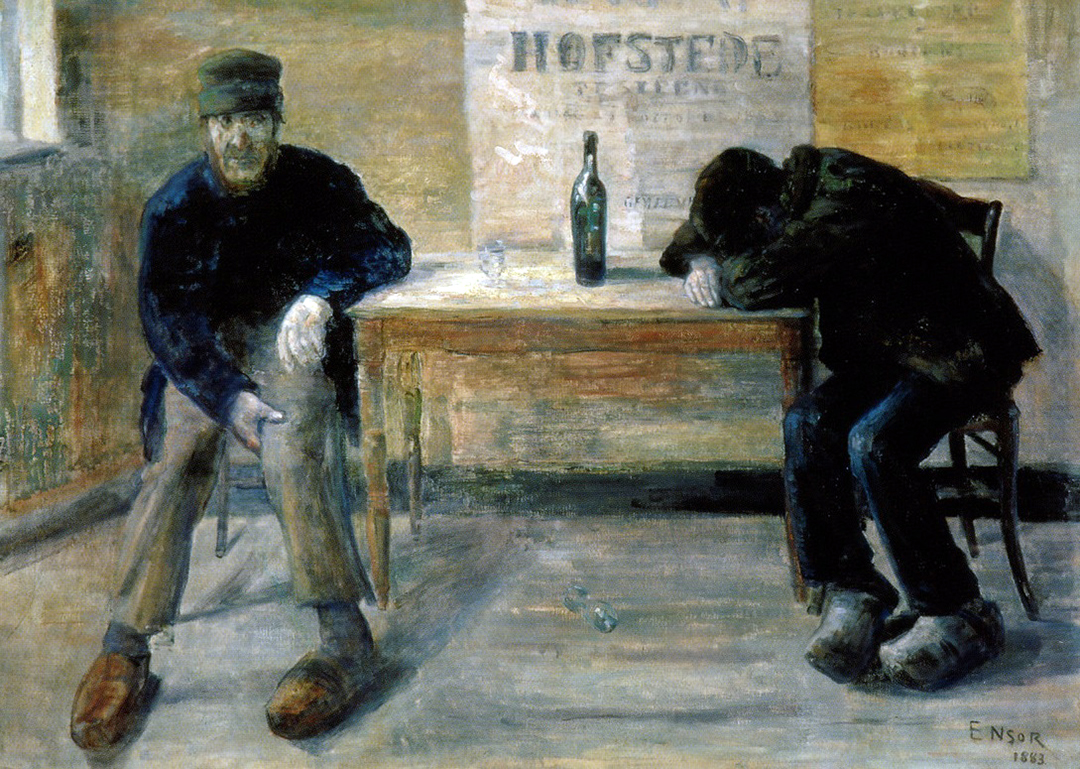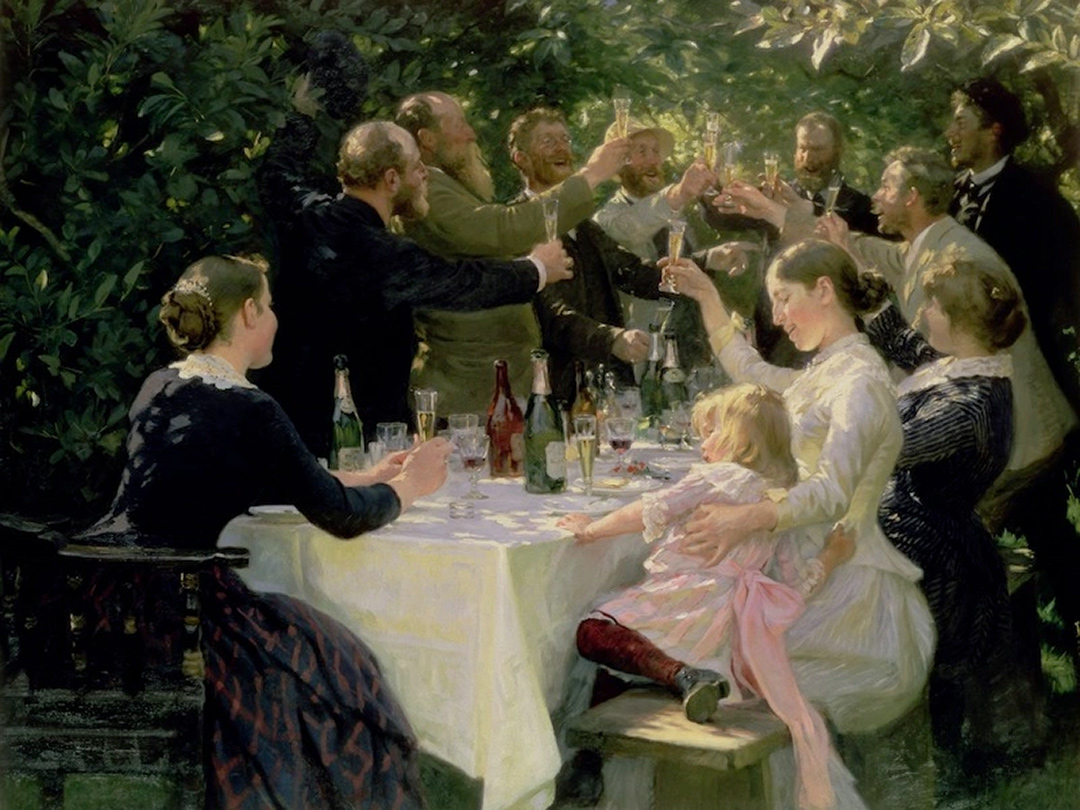“With wine and hope, anything is possible.”
Spanish Proverb
 Hyperallergic: “A Food-Obsessed Frolic Through Western Art History” [*]
Hyperallergic: “A Food-Obsessed Frolic Through Western Art History” [*]
“The artist François Boucher knew how to use food as a ruse. The Rococo master’s 1746 painting “Pensent-ils au raisin? (Are They Thinking about the Grapes?)” presents a tempting scene of consumption. Lounging amid goats and sheep under feathery trees, a young lady in a blush-colored gown extends a single grape towards her shepherd-lover’s mouth. The grape is the exact hue of her own flesh, and the shepherd’s fingers gently cradle the bunch that she dangles over her lap. The work’s now-famous title — later immortalized in a widely circulated print by Jacques Philippe Le Bas — reflects Boucher’s winking, playful sensuality. After all, who would be worried about grapes, or any other food, at a seductive moment like this?
As it turns out, Leonard Barkan would. His book The Hungry Eye: Eating, Drinking and European Culture from Rome to the Renaissance (Princeton University Press) is a food-obsessed frolic through the artwork, writing, and philosophy of hundreds of years of Western history. A Renaissance scholar, art historian, and food and wine writer, Barkan organized his book according to his self-proclaimed ‘hungry eye,’ which roves from Pompeiian mosaics to Bible passages to Shakespearean plays in search of food and drink. This approach, which Barkan calls “reading for food,” interrogates occurrences of hunger, thirst, flavor, and pleasure in ancient to early modern culture as catalysts for new interpretations of life and meaning in the Western world.”*Quotation above is taken directly from the website cited and is the property of that source. It is meant to inform the reader and to give credit where it is due.
 Vivanco: “Six Artists Who Brought Out the Best Art in Wine” [*]
Vivanco: “Six Artists Who Brought Out the Best Art in Wine” [*]
“Few beverages are as closely associated with the history of mankind as wine, and even less so with the history of art. It is possible to find frescoes from ancient Egypt depicting everyday scenes associated with the world of wine (such as the treading of grapes). In ancient Greece, there were sculptures and paintings depicting scenes of grape harvesting, as well as a multitude of works dedicated to Dionysus, the god of the grape harvest and wine, the inspirer of ritual madness and ecstasy.
For centuries, grapes and wine have posed countless times for painters and sculptors who have depicted them in a multitude of forms and tastes. Artists such as Rubens, Titian, Leonardo da Vinci, Michelangelo, Velázquez, Goya, Van Gogh, Picasso, Andy Warhol and Botero have been inspired by grapes, wine and all its symbolism throughout history. In the Museum Vivanco of Wine Culture you can see some of their works.
” If you drink water, you can never produce a work of art”, said the Greek poet Cretinus. Today this statement would probably be questioned by some of the artists I will introduce you to below. The fact is that the painters we will talk about today do not use wine to drink it, but to paint their pictures!”*Quotation above is taken directly from the website cited and is the property of that source. It is meant to inform the reader and to give credit where it is due.
 Of Art and Wine: “An Art History C.S.I. and Wine and Poison, a Lethal Combo” [*]
Of Art and Wine: “An Art History C.S.I. and Wine and Poison, a Lethal Combo” [*]
“Well, there he is, a Renaissance rock star without the rock music. What he rocked was painting. You can tell by the expression on his face that he was a no-nonsence type of guy, rough around the edges and maybe at the core as well. While his given name was Tommaso, or Thomas, he was known as a big fellow who cared little for personal grooming, thus he was nicknamed, Masaccio. In its kindest form it means Big Thomas, but it also means Messy Thomas or Dirty Thomas. He blazed brightly in Florence in the 1420s before taking his talent to Rome in 1428, the hot spot for papal commissions. However, he never returned, as someone supposedly killed him there that same year. Our search to find out what happened begins there and with two of the several competing theories about how he died.
According to a version I heard in an art history lecture I attended when living in Avignon, France, former seat of the Papacy, Masaccio’s fame preceded him to Rome where major jealousies were inflamed among the other artists vying for those papal commissions. This was added to by reports that Masaccio had developed a secret formula for creating a brilliant red. In fact, he had already shown his penchant for color in his works in Florence (see the portrait of St. Jerome in his red cardinal’s robes).”*Quotation above is taken directly from the website cited and is the property of that source. It is meant to inform the reader and to give credit where it is due.
 Bright Cellars: “We Just Found the Best Wine Pairing: Art and Wine” [*]
Bright Cellars: “We Just Found the Best Wine Pairing: Art and Wine” [*]
“Have you ever wondered what wine would pair with your favorite art movement? Me neither, but I thought it’d be fun. Follow me through this quick art history lesson and enjoy some wine along the way. The Renaissance artists were drama kings. (Feminism wasn’t cool yet.) Back then, intense light and shading was the modern-day Instagram filter. In the Mona Lisa, Da Vinci fused the subject with the background using a hazy or dreamlike effect called sfumato. So you know, he went bold with #nofilter. Also originating in Greece and Italy, Muscat Blanc was likely Mona Lisa’s wine of choice (and probably made her feel hazy, too). High in fruit and acidity, this wine is commonly characterized by lemon, orange and pear flavors.
The Romantics were an 1880s version of the modern-day tree-hugger. A very emotional bunch, they could look at a flower and start to cry. Riesling is definitely the wine to pair with these lovers. Originating in Germany, Riesling is full of natural, fruity flavors like lime, green apple and beeswax. A wine so beautiful, it’ll probably make you cry too. The Impressionists ain’t got time for that. Working outside, their style was fast and sketchy, aiming to capture the quick-changing natural light. They were all about the sensory experience. Since he worked in Paris, I’m guessing Claude Monet sipped (rapidly) on that Rosé, soaking in the floral and fruity flavors.”*Quotation above is taken directly from the website cited and is the property of that source. It is meant to inform the reader and to give credit where it is due.
 Wine and Other Stories: “The Bacchus by Caravaggio – The Wine Lover That Became Art” [*]
Wine and Other Stories: “The Bacchus by Caravaggio – The Wine Lover That Became Art” [*]
“Once upon a time there was a curious child that liked to run at breakneck speed through the corridors and rooms of an old house. Occasionally, the child would stop at the door of the living room transfixed by a painting hung there. The painting was of a young man bare but for a simple robe draped over his left shoulder. Muscular, with a relaxed and engaging expression upon his face. Holding a glass of ruby-coloured wine, the man almost seemed to stare at the kid with an attitude in between seduction and generosity, grace and satisfaction. That child was me, more or less thirty years ago. The painting, an almost perfect replica of one of the most important masterpieces created by Michelangelo Merisi, aka Caravaggio. I’m talking about the Bacchus, a painting that fascinates me as much today as it did three decades ago.
Dating from around 1595, the Bacchus is currently held in the Uffizi Gallery, Florence. It was commissioned by Cardinal del Monte the year after Caravaggio entered his court, during his prolific Roman period. The Bacchus was Caravaggio’s first classically inspired portrait. The youthful man, in a subtle sexualised pose, lays on a Roman couch dressed in simple drapery. His hair crowned with a wreath of grapes and leaves. With his left hand he offers the viewer a wide goblet of red wine. The liquid’s surface still rippling from his movement. The man’s right hand casually plays with his sash, which loosely holds his drapery together. In front of the man lies a basket of ripe fruit and a large carafe of wine – the same wine he offers in the goblet?”*Quotation above is taken directly from the website cited and is the property of that source. It is meant to inform the reader and to give credit where it is due.


